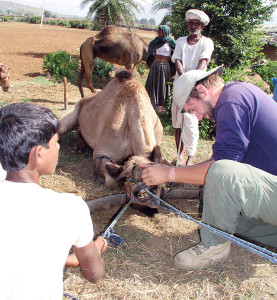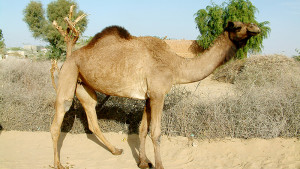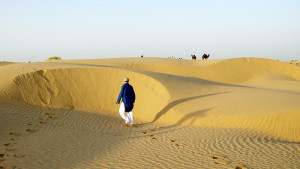“Will They Not Consider How Camels Were Created?”
[Al-Qur’an 88:17-21]
Often referred to as the “Ship of the Desert” The Arabian Dromedary Camel or Camelus Dromedarius to give it its binomial Latin name for genus and species is a two toed ungulate with a single hump on its back. It is much larger and less hairy than its northern cousin, the Bactrian which has two humps. A simple way to remember the difference is:
Camels are often misunderstood and people refer to them as the “Beasts who spit” or “as lazy as a camel” or “as foul tempered as a camel”. These myths have arisen from the camel’s temperament which is a coping mechanism for the environment it lives in.
Firstly camels are constant ruminators which means that they have two stomachs and they constantly regurgitate food and re-chew it to help digest it properly. This process can result in spittle forming around the corners of the mouth and if you are in close proximity to a camel’s face it can mean you periodically get flecks of spit on you too. Secondly camels are not lazy in fact a trained camel can carry more than a 3rd of its own body weight for up to 50kms a day without straining itself. Thirdly camels can see down the sides of their bodies due to the angle of their eyes and this means they are aware of anything approaching from behind and if that’s you then it’s likely to get you a good hard kick in the midriff!
The truth is that camels mostly live in extreme desert environments both in the hot deserts of Arabia or Africa or Australia and in the cold deserts of the north in Mongolia and Ladakh etc. They have therefore learned to conserve water and to do this they tend to be fairly calm and relaxed, often choosing to kneel for long periods to conserve energy. That energy is stored in fat reserves in the hump and is easily broken down to release water but it’s not so easy as opening a tap in the side of the hump. That being said, the hump has very few nerve endings and in times of real desperation the Bedouin are known to cut a flap in the skin of the hump dig out fat with a spoon to fry to eat. The flap quickly closes and heals again. This is actually quite a common practice in the world and you will find the Masai Mara of Africa pierce the neck of cattle to draw hot blood which they mix with fresh milk as a quick energy source. The Mongolians also used to do the same thing with their horses as a quick energy boost. The wound is easy to close by rubbing a handful of dirt into it which helps the blood to clot.
All creatures develop specific adaptations for the environments they live in. But it’s fair to say that Camels are one of the most highly adapted animals on the planet.
Their eyes have a second, see-through nictitating eyelid which they can close in a sandstorm to protect the eyeballs but still be able to see – like having your own sand goggles built in! Their eyelashes are extra long and bushy to catch dust particles before they reach the eyes. The nostrils are flared and wide to make it easier to draw breath, but they also have flaps inside that they can close to stop sand blowing up their nostrils. The hair is short and thick which allows them to radiate heat off their body during the day but also to trap a layer of air next to the skin at night to insulate the body. The tail is long with bristles on the end to act as a fly swish. The neck is long to reach high into trees to get the leaves other animals can’t reach and the tongue and lips are thick and leathery which makes the camel one of the only animals in the desert which can comfortably eat the thorny acacia scrub and bushes. These bushes and trees have the adaptation to defend against wondering grazers of having needlelike thorns but the camel has adapted to get past those too!
The neck is long to reach high into trees to get the leaves other animals can’t reach and the tongue and lips are thick and leathery which makes the camel one of the only animals in the desert which can comfortably eat the thorny acacia scrub and bushes. These bushes and trees have the adaptation to defend against wondering grazers of having needlelike thorns but the camel has adapted to get past those too!
Even the blood of the camel has adaptations. In extreme heat when the body is low on water, our blood gets thicker which makes it harder for the red blood cells to flow round the veins transporting oxygen. This makes us increasingly tired. But camels have adapted so at times like this their red blood cells change shape from footballs to rugby balls (elongated) which makes it easier to flow through the veins and carry that all important oxygen!
The camel’s foot is split into two toes and the pad at the base is thick with very few nerve endings. This allows the camel to both walk on soft sand without sinking but also to walk on very hot sand without burning. Another adaptation to avoid burning is to develop thick calluses over the knees and the centre of the breast plate. This lets the camel kneel down to chew the cud, wait out a storm or sleep and they don’t burn on the hot sands. Interestingly the camel’s foot is similar to a human fingerprint and you can learn to identify individual camels by their tracks which make tracking one camel through a herd much easier.
Because of the way a camel kneels down to rest its legs have a double jointed quality that also means a camel can kick at basically any angle from standing! This means that if you don’t treat a camel’s personal space with respect and inform them that you are approaching them you are fair game for a good kick! The downside to this ability is that a camel’s weakness lies in its lack of strength between its legs so it has to be very careful when walking on mud not to slip which can make the legs to splay outwards causing damage to muscles and connective tissues.
If you are lucky enough to work with camels then there is an etiquette you will need to learn. Camels are very intelligent and you can develop a great friendship with your camels. I personally feel that they are more intelligent than horses and I prefer to work with camels. In 2004 I rode 1,600kms across India to Nepal with four camels and an American writer called Jim Wiltens. It took us four months and we had to train our camels first to be able to undertake such a long journey. We learned a huge amount and for the whole expedition I made weekly radio reports by satellite phone for BBC radio in the United Kingdom. The biggest thing I learned is that camels are very inquisitive. They are always interested to see what is going on. Don’t be surprised if you are parked with your windows open and a camel wants to put its head into the car. They literally want to say hello! Humans in the Middle East nose kiss for greeting and camels do the same thing when they meet. In a similar way to horses they bring their noses together to blow air into each other’s nostrils which is very calming. If you want to calm a camel down then you can nose kiss them in greeting. Camels also like to have their necks rubbed but make sure you announce your presence next to them before you do it if you don’t want a kick!
I have written an article before about the Dhafra camel festival which is a celebration of everything to do with the camel and desert culture but one thing I haven’t seen in the Middle East is camel dancing which is extremely popular in Rajasthan in the Thar Desert (India). Here the local Reikah tribes teach their camels how to dance to music or drum rhythms and they dress them up in brightly coloured clothes and bells. This is great fun to watch and the camels themselves are treated like royalty and obviously enjoy the dancing. I can say this with certainty because I have trained in camel riding with a real life camel dancing trainer and he was a very gentle man who could “whisper” a camel like horse whisperers do and they would do anything for him.
If you want to read and account of my adventures with camels in India with the author Jim Wiltens then you can get a copy of his book on Amazon – Deer Crossing Press, “Camels, Skulls and Cobras: A Wild Ride Across India”.
Words + Photos by: Dan Wright




